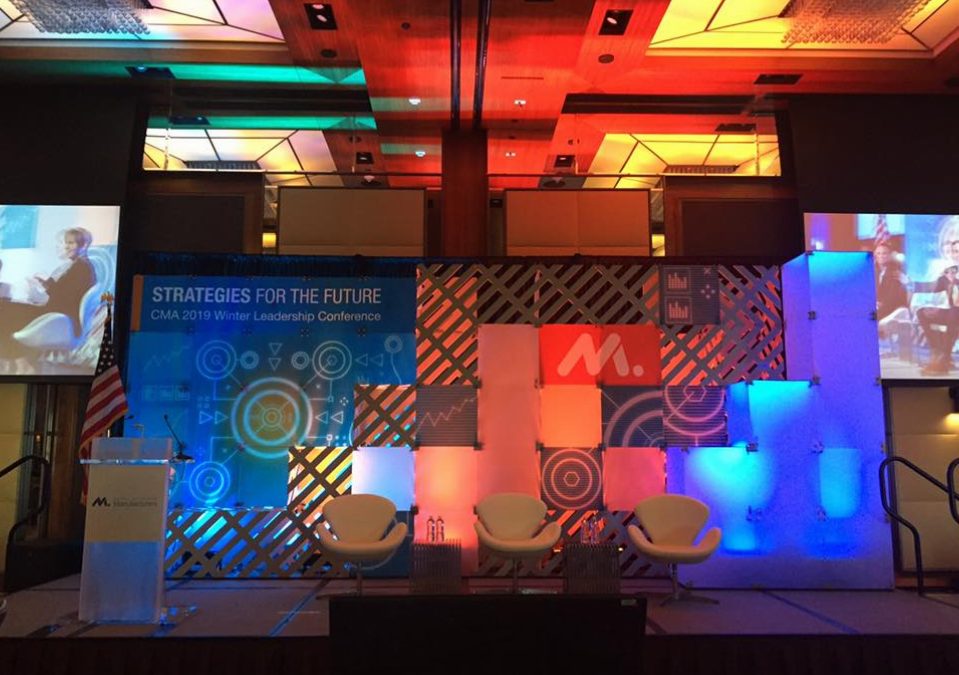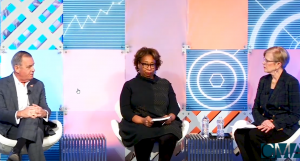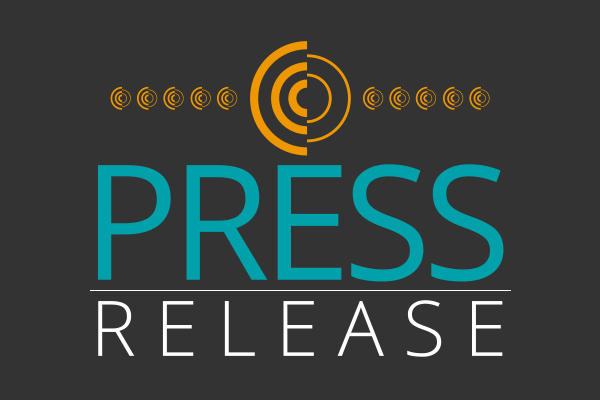
by Rich Finstein | Jan 28, 2019 | Blog, Customer Stories, Education
When organizations consider holding a livestream program from a place based conference or a completely virtual event, a common question asked is, what content will be compelling enough to get people to pay attention?

Click to view the livestream.
Several weeks ago CommPartners was asked to livestream a session for the Council of Manufacturing Associations (CMA) in cooperation with the American Society of Association Executives titled: Unconscious Bias: An Association’s Role in Social Issues. The program originated from CMA’s Winter Leadership Conference that took place at the Four Seasons in Baltimore, MD, on Friday January 11, 2019. The archive of that event can be accessed here.
Of all the possible topics to livestream, CMA chose this subject because they knew, organizations are wrestling with their role in today’s political and social discourse. It’s a topic that transcends professional development training and presents an opportunity for community conversation and engagement. CommPartners’ role was to bring this session to the remote audience and to make them feel as if they were onsite and provide opportunities to share thoughts and ideas.
Taking risks and considering alternative formats for livestream programs can position your organization to extend your reach and impact. It can place you at the center of important conversations we are all having.
|
|
As a result of using the livestream format for a more personal and compelling topic, CMA was able to realize five key benefits:
- They greatly increased their profile to individuals and groups who otherwise would not be aware or involved with the CMA.
- Attending an onsite conference is expensive. By offering a session like this one, they were more inclusive and recognized the importance of reaching out to those who could not afford to attend or didn’t have the ability to travel or leave their homes or offices.
- CMA, along with ASAE took the lead in forging the conversation around hidden social bias. They showed who they are and what they are about by addressing the topic in public way. This showed is pays to be bold.
- This was a session from the heart. Online attendees were touched by the format and conversation.
- The session used a dramatic delivery that worked well to engage those in the room as well as those online. You had to walk away with a wow feeling as you watched the event. It’s the type of session that creates interest and a positive feeling about the host organization. If you are a member, it solidified your feelings about your investment. If you aren’t a member and this was your first experience, you had to walk away impressed.
|
This program was a collaboration between CommPartners, Council of Manufacturing Associations and the American Society of Association Executives. It was an important topic that has relevance to the greater association community. As the production company, we were proud to help extend the reach of this session to online viewers around the country.
For additional information about CommPartners Elevate platform integrated with Higher Logic Communities, contact Meghan Gowen at mgowen@commpartners.com

by Rich Finstein | Aug 23, 2018 | Blog
It’s hard to believe that the TV show, Cheers, had its last year on air in 1993, which is actually the year CommPartners was founded. People remember that Cheers, the name of the bar in the show, was a welcoming place because everyone knew your name when you walked in. People felt they belonged. They were recognized and appreciated.
So what does Cheers have to do with an LMS? It’s rather simple. When we invest our time and energy when accessing an organization’s LMS, we want to be recognized and provided relevant opportunities to our interests and education needs. Associations, as well as other types of organizations, know quite a bit about their learners. Just like people that walk into their friendly neighborhood tavern, it’s important to offer a welcoming environment that becomes the go-to place for our stakeholder’s online education needs.
So how can you create your LMS be to be the Cheers of online learning? With Elevate LMS, we strive to enable our clients to be their communities’ favorite learning destination. Here are five ways that we support the Cheers approach:
Elevate Relevancy Engine: When learners first log into Elevate, they are able to select their interests and “likes.” On future visits, Elevate recognizes the learner and presents programs of interest to them.
AMS / Community Integrations: We think of integrations as functional processes to connect two or more platforms. With Elevate, integrations provide additional value. It allows organizations to decide which content should be seen by which stakeholder. If it’s not relevant, why show it and clutter the experience? Pricing by learner type can also be automatically established.
Roles: In addition to member type, Elevate can further delineate who a learner is based on their role within the organization or other designations, such as a practice group. Roles also determine pricing and access.
Private Branding: Private branding can be unique for groups of learners from organizations. Seeing the unique design reinforces the relationship between you and your client.
Automatic Triggers: Like frequent flyer miles, automatic triggers assign credits based on rules that are established, such as a member renewing their membership.
All of these benefits provide a way of saying – I know who you are and based on your role or interests, we are providing you learning engagement opportunities that are just for you. In other words, this a place where you feel welcomed and have a relevant, individualized experience.
It’s the place where we know your name.
If you would like more information Elevate LMS, give us a call at (800) 274-9390 or fill out our online contact form to get in touch with someone.

by Aubrey Mellos | Jul 9, 2018 | News
Department of Commerce Certification Highlights CommPartners’ Commitment to Privacy
Columbia, MD – July 10, 2018. CommPartners, provider of Elevate Learning Management System, webinar, webcast, and livestream solutions has been certified by the U.S. Department of Commerce and the European Commission under the EU-U.S. Privacy Shield Framework.
The EU-U.S. Privacy Shield Framework provides companies on both sides of the Atlantic with a mechanism to comply with data protection requirements when transferring personal data from the European Union and Switzerland to the United States in support of transatlantic commerce.
“CommPartners is committed to protecting the privacy of our customers and their users. Our customers are very important to us and we want to ensure that their personal information is always safeguarded. We voluntarily self-certified with the EU-U.S. Privacy Shield Framework to ensure our customers have the most up-to-date and appropriate protection,” said Richard Finstein, CEO, CommPartners.
Client data and proprietary information is used by CommPartners for the sole purpose of creating more relevant learning experiences for users of Elevate Learning Management System. CommPartners will only partner with reputable organizations who share in the commitment to maintain a secure environment of user data.
You can read CommPartners’ privacy policy here. You can view CommPartners’ EU-U.S. Privacy Shield Framework certification here. For more information about the EU-U.S. Privacy Shield Framework, visit www.privacyshield.gov.
About CommPartners
CommPartners is a leading provider of online education and event solutions. At the core of the company’s solutions is our Elevate Learning Management System. To extend the value of Elevate LMS, we provide a wide range of online education services including curriculum design, instructional design, fully managed webinars, webcasts, livestream programs and virtual conferences. To learn more visit: www.commpartners.com.
###

by Aubrey Mellos | May 31, 2018 | Blog
Guest blog by our partners at WebMechanix
Creating a webinar that sells is one of the best ways to generate revenue online. There’s no better way to get in front of your target audience and wow them.
So, are you sure you’re fully optimizing your webinars for conversion? The truth is everything from promotional emails, to how you hook attendance, to how you present your offer ultimately affects your sales.
After extensively researching webcast and webinar best practices, and drawing from our own experience, we have found some powerful ways to optimize webinar sales.
Today, we’re sharing the top six webinar tips and tricks that have the highest impact on the bottom line.
The class is in session…
1. Prepare and Practice
WebMechanix marketing manager, Clare French, has conducted countless webinars over the years. She highly recommends making sure you plan and practice beforehand.
You’ll want to outline the marketing automation plan for your webinar follow-up process early. Nail down the dates you’ll have your slides and other content emailed to your attendees, and have your sales and support teams follow up personally with prospects and customers afterward.
Many platforms have a practice mode for presenters to sync up just before the event starts. Taking a few minutes to make sure everyone is on the same page about the technical set-up and behind-the-scenes communication is invaluable to the attendee experience. There’s nothing worse than a presenter fumbling through the presentation because they don’t know the basics of the tool.
Schedule at least one practice run 3-5 business days before the event. Doing it earlier allows more time to make changes and regroup once more if needed.
Always give “housekeeping” tips at the start of a webinar to let attendees know how to communicate with the presenters. These tips should set the precedence for when questions are answered (in the moment versus at the end), and gives you the opportunity to set expectations about following up with attendees.
2. Use Organic (and Paid) Social Promotion Beforehand
Your webinar is a one-time, live online event. It’s powerful because you get to interact live with your audience. Squeeze all the juice out of it by filling as many seats as you can.
When it comes to webinar promotion best practices, be sure to get all the presenters and partners to promote the webinar on their social and professional profiles beforehand. Also, if you have the budget, use paid ads on Facebook, LinkedIn, and even Instagram.
3. The Magic is in the Q&A
Out of our six webinar marketing tips, this simple tweak may yield the most to your bottom line.
Make sure you answer attendee questions and interact with them during your webinar. That’s the beauty of a live event. Otherwise, you may as well do a pre-recorded presentation.
Tim Paige of LeadPages, world record holder for most webinars conducted, tripled revenue and increased attendee stick rate, the percentage of the event an attendee stays, to an impressive 98%. He did so with one tweak: answering questions during the presentation rather than at the end.
When answering questions, keep it natural. Make sure you don’t destroy the flow. Answer a handful of questions at regular intervals during your webinar. Mention the inquirer’s name and the question out loud before you answer to re-engage attendees.
4. Measure Yourself Against Benchmarks
Webinar engagement metrics (based on CommPartners clients) typically look like:
- 50% attendance rate for free events; 65-75% for paid or credit events
- 75-80% participate in polls
- 5-10% participate in the chat
- 50-60% download presentation slides
By using benchmarks, you can effectively gauge the success of your webinar optimizations. If your live events aren’t performing as well as you’d hope, benchmarks can help you can identify potential issues and adjust. Stats can give great insight into how you can improve your webinar engagement and stick rate. For example, considering using emoticons and interactive behavior to help with stick rate.
5. Provide a Real Phone Number
At the end of your webinar, offer a number for people to call with questions. You often can’t answer everything on the presentation and prospects may only think of a good question after it’s over.
Russell Brunson, the founder of an eight-figure SaaS company, was already implementing a ton of webinar tips and tricks. Then, he tried something new that increased webinar sales by 25%. At the end of his webinars, he offered a Google Voice phone number to call and leave questions — and he called everyone back with an answer.
If you have call center capacity, consider experimenting with a live phone number to answer questions immediately. There’s a reason why infomercials do this: it works. Creating a webinar that sells depends as much on the quality of the follow-up process as the event itself.
6. Double Down on What’s Working
After you have a few webinars under your belt, you’ll notice specific parts of the process that catapult results and others that peter out. To sculpt the perfect webinar, double down on what’s working.
If storytelling balloons attendance, duration, and sales conversion, do it more often. If sending three emails instead of four before the event leads to more attendees, send three. If a tweak to your Facebook ad doubles conversion rate, scale up your ad budget.
This tip may sound more like common sense than an effective webinar tip, but common sense isn’t always so common. With all the moving parts to hosting a webinar, it’s easy to forget about doing more of what’s working when there’s so much to juggle.
Every part of the process has room for optimization.
Pro Tip: If you change your Facebook ad creative to focus on the solution you offer rather than your personal branding and face, it performs better with a cold audience. Your face doesn’t convert as well because they don’t know who you are yet.
Conclusion
By implementing these six webinar tips and tricks, you’ll see higher attendance, more engagement, and a more extended attendee stick rate. And all of these tactics together help you create a webinar that sells.
Since webinars can get confusing with all the moving pieces, focus on these fundamentals, and you’ll be on your way to a sales-optimized webinar process with a lot less headache.
What’s your favorite part of a webinar?
As a webinar production company, CommPartners has over 25 years of experience providing webinar and webcast hosting services to clients. If you’re looking for someone to host your webcast, or need general help with webinar management, fill out our online contact form or give us a call at (800) 274-9390 to see how we can help.

by Rich Finstein | May 7, 2018 | Blog
When an organization begins the process of evaluating LMS options, they typically will start by developing a list of features that should be included. Confirming this list helps to identify ideal candidates. While the feature set is critical to narrow an organization’s search process, often an element that is overlooked, at least initially, is the User Experience or “UX”.
The UX as defined in Wikipedia refers to: “A person’s emotions and attitudes about using a particular product, system or service. It includes the practical, experiential, affective, meaningful and valuable aspects of human–computer interaction and product ownership.”
So much of what we do today is defined by the user experience. An impactful example is the mobile device we interact with hundreds of times a day. UX design also applies to mundane products such as a coffee cup or the toothbrush we use. But how about interacting with an LMS? If we want to ensure that learners have an excellent experience when accessing education opportunities, it’s critical to make sure that every element of our learning management site is attractively designed, intuitive to navigate, is relevant and meaningful.
Here are five recommendations to ensure your Learning Management System fulfills your learners’ expectation of an exceptional user experience:
- Choose an LMS that provides complete control of every aspect of the design.
You have invested in the development of your website to ensure it presents your organization in the best possible way. You most likely do not want to implement an LMS that feels like a separate component. Ideally your learning site will be nimble enough to incorporate your website styling, navigation, layout, imagery, fonts and taxonomy. Having an LMS with visual congruence to your website will eliminate a disconnect of having two separately hosted online components.
- Ensure that your LMS works seamlessly with your ecosystem of applications including your AMS (database) and private online community.
When a learner moves to and from your LMS, does the experience feel disjointed? It is important to provide visual congruence through your entire ecosystem of web platforms so the user experience will be not be compromised. In addition, it is important to integrate with these systems to ensure login credentials are carried through all applications. This will create seamless navigation and enhance the overall experience.
- Establish a style guide to be applied throughout your site.
It’s important to have a set style guide that addresses every design element of your LMS. This applies to both the platform and contents. Choose a platform that provides you design flexibility for all elements. Make sure that your staff or anyone that works with your LMS adheres to your guidelines. It shows when certain elements do not adhere to the standards you have set, therefore compromising the User Experience.
- Create a relevant and simple process for accessing content.
Ideally the LMS experience can be personalized for each learner so when they login in, they are presented content that is relevant to their needs. This can be done in multiple ways. The first is using information you already know about a learner and presenting the right access, pricing and topics. A second way to is to allow the user to set their interests and prioritize the presentation of content based on those interests. Having customized experiences fosters loyalty and return visits to your site. To support simple access of content, avoid scrolling to find programs. Instead, provide the right amount of content per screen.
- Make registration and checkout clean and simple.
Ideally, in a matter of a click or two the learner will be able to register and access their selected program. When they land on the shopping cart page, it should be clean and simple. Once the registration is completed, the learner is seamlessly directed to the content that they register for. When the User Experience is exceptional, the exposure and value of your learning programs is increased. The UX represents you in a highly public way and it’s important to ensure it positions your organization for success.
If you would like more information on UX Design for your LMS or the CommPartners Elevate LMS, give us a call at (800) 274-9390 or fill out our online contact form to get in touch with someone.







